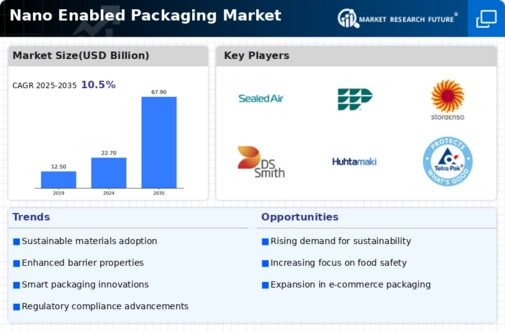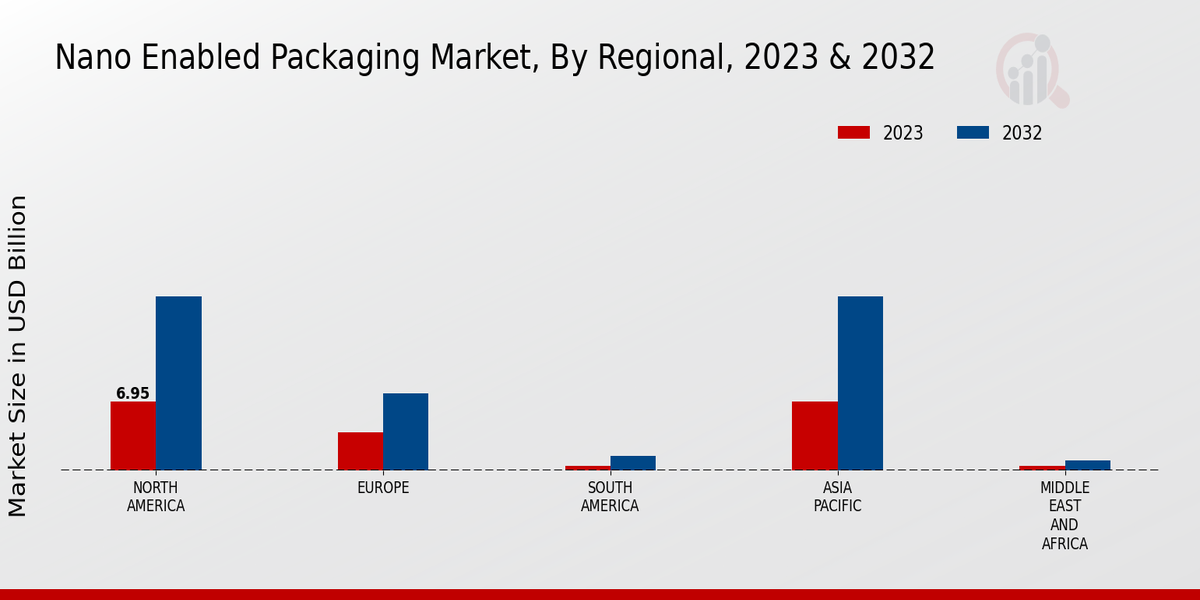Enhanced Shelf Life
One of the primary drivers of the Global Nano Enabled Packaging Market Industry is the enhancement of shelf life for food and pharmaceuticals. Nano-coatings and additives can create barriers to oxygen, moisture, and light, which are critical factors in spoilage. For example, packaging that incorporates nanotechnology can extend the shelf life of perishable goods, reducing food waste significantly. This is particularly relevant as global food waste is estimated to be around 1.3 billion tons annually. By 2035, the market is expected to grow to 67.9 USD Billion, indicating a robust demand for packaging solutions that prolong product freshness and safety.
Market Growth Projections
The Global Nano Enabled Packaging Market Industry is poised for substantial growth, with projections indicating a market size of 22.7 USD Billion in 2024 and an anticipated increase to 67.9 USD Billion by 2035. This growth trajectory suggests a compound annual growth rate (CAGR) of 10.47% from 2025 to 2035. Such figures reflect the increasing adoption of nanotechnology across various sectors, including food, pharmaceuticals, and consumer goods. The rising awareness of the benefits of nano-enabled packaging, coupled with advancements in technology and sustainability initiatives, positions the industry for a robust expansion in the coming years.
Sustainability Initiatives
The Global Nano Enabled Packaging Market Industry is increasingly driven by sustainability initiatives. Companies are adopting nano-enabled materials that enhance the recyclability and biodegradability of packaging. For instance, nanomaterials can reduce the amount of plastic used, thereby minimizing environmental impact. This shift aligns with global efforts to reduce plastic waste, as seen in various regulations and consumer preferences favoring eco-friendly products. The market is projected to reach 22.7 USD Billion in 2024, reflecting a growing demand for sustainable packaging solutions. As consumers become more environmentally conscious, the industry is likely to see a significant transformation towards greener alternatives.
Technological Advancements
Technological advancements in nanotechnology are propelling the Global Nano Enabled Packaging Market Industry forward. Innovations in material science have led to the development of new nano-composites that improve mechanical properties and barrier performance. For instance, the incorporation of nanoparticles in polymers can enhance strength while maintaining lightweight characteristics. This is particularly beneficial in sectors such as food and beverage, where packaging integrity is paramount. The anticipated CAGR of 10.47% from 2025 to 2035 suggests that ongoing research and development will continue to yield novel applications, further driving market growth and adoption of advanced packaging solutions.
Consumer Demand for Convenience
The Global Nano Enabled Packaging Market Industry is significantly influenced by consumer demand for convenience. Modern consumers increasingly seek packaging that offers ease of use, portability, and extended product life. Nano-enabled packaging solutions, such as resealable pouches and smart packaging with indicators for freshness, cater to these preferences. As lifestyles become busier, the need for convenient packaging options grows, driving innovation in the sector. This trend is expected to contribute to the market's growth, as manufacturers respond to evolving consumer behaviors and preferences, thereby enhancing the overall appeal of nano-enabled products.
Regulatory Support and Standards
Regulatory support and the establishment of standards are crucial drivers for the Global Nano Enabled Packaging Market Industry. Governments worldwide are recognizing the potential benefits of nanotechnology in packaging, leading to the development of guidelines and regulations that promote safe usage. For example, the European Union has implemented regulations that encourage the use of nanomaterials in food packaging, provided they meet safety standards. This regulatory framework not only fosters innovation but also instills consumer confidence in nano-enabled products. As regulations evolve, the market is likely to experience accelerated growth, with manufacturers increasingly adopting compliant nano-packaging solutions.



















